 |
PO
Box 9021, Wilmington, DE 19809, USA
E-mail: font@focusonnature.com
Phone: Toll-free in USA 1-888-721-3555
or 302/529-1876 |
THE FOCUS ON NATURE TOUR IN CHILE
November 2011
"In
the land of the Puma and Pudu, Parakeets and Penguins"
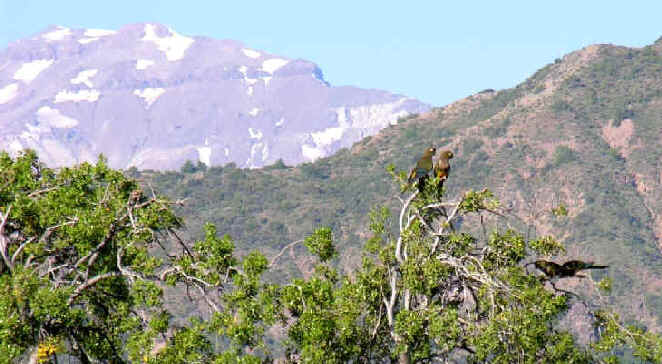
Chilean
countryside with Burrowing Parakeets in the tress
Links:
List
of Birds & Other Wildlife during the FONT Chile Tour - November 2011
A Gallery of Photos from our November 2011 Chile Tour
Some
of the Accommodations during our November 2011 Tour
A Feature with Some Poems about Birds by Pablo Neruda
(with photos)
A
Complete List & Photo Gallery of Chile Birds, in 2 parts
Mammals in Chile (with some photos)
Upcoming
FONT Birding & Nature Tours in Chile

The following narrative of the FONT Nov
2011
Chile Tour was
written by Armas Hill, the tour leader:
The Puma, of course, is the widespread American mammal
also known as the Cougar or Puma. It is common in
parts of Chile, but a hard animal to see. No, we did not see one
during our November 2011 birding
& nature tour in Chile, except on a couple highway billboards
relating to Chilean wildlife. Maybe next time. Hopefully. We'll try.
But one of the 6 species of wild cats in Chile was seen, a Kodkod
(kind of like a Bobcat, but with a longer tail).
A Pudu was seen. It is a small deer, actually the world's
smallest deer. The shoulder height of an adult is 16 inches off the ground.

The Pudu
Another mammal seen during the tour was a mostly silver-gray and black mustelid (a
weasel-like animal), the Lesser Grison, known locally as
the Quique.
And in the same family, at a rocky seacoast, we saw the Marine
Otter (similar to, but smaller than the Sea Otter). It
is known locally as the Chungungo.
During our November 2011 Chile Tour, we did
see both parakeets and penguins, among the
many birds that we enjoyed.
A rare, endangered, and localized bird in Chile is the Burrowing
Parakeet, a large parakeet about the size of smaller macaw. Also called
the Patagonian Conure, it has an array of colors. Its
upper-parts and long tail are olive-green. Its rump is yellow. Its head is
olive-brown. It has a gray forecrown and white around its eyes. It has a white
breast band. Its abdomen is yellow, with a streak of red on its belly. Its wing
primaries are blue. It has yellow legs and pale red feet. Putting all this
together, the bird has, yes, an array of colors. The species also
occurs in Argentina, but west of the Andes in Chile, where it is called the
Tricahue, it is an isolated, endemic subspecies.
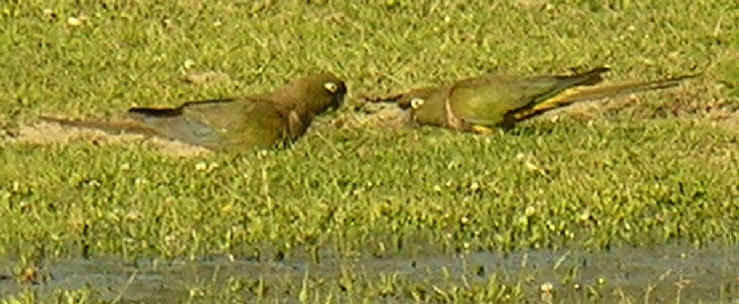
Not all of their colors can be
seen here, but these two Burrowing Parakeets
were feeding in the afternoon sunlight on the ground.
Also notable, and classified as a near-threatened species, is the Slender-billed
Parakeet, that's endemic to southern Chile. An interesting and
distinctive feature of the bird is its elongated upper bill, much longer
and thinner than its lower bill. Noisy as they fly about, these parakeets,
especially in the late afternoon, are an obvious part of a
southern Chilean scene that includes snow-capped volcanoes, lakes, forests, and
pastures with scattered large trees. The long, thin upper beaks are used to
crack seeds in the cones of Araucaria trees, or Nothofagus seeds and
bulbous roots in the ground.
A third Chilean parakeet, the Austral Parakeet, while not with
features as distinctive as those of the Burrowing and Slender-billed
Parakeets, is still notable in that it is the southernmost parakeet in
the Americas. An alternate name for it is the Emerald Parakeet.
Two species of penguins that we saw on rocky
islets, along a picturesque stretch of the Chiloe Island seacoast, were
close together, but apparently breeding with their own kind. Superficially
similar, they were the Humboldt and the Magellanic
Penguins. Basically, the Humboldt breeds along the
Pacific Coast of South America from that Chiloe Island site north, while the Magellanic
breeds from there south (and also on the Atlantic side of southern South
America).
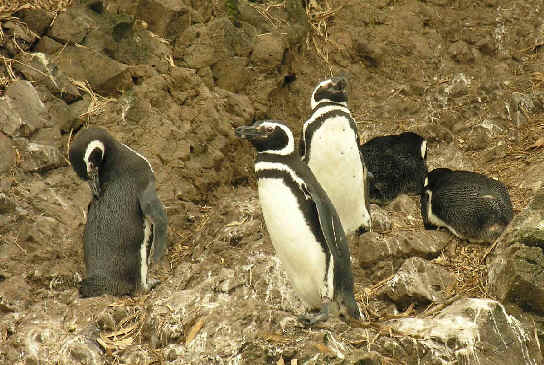
Magellanic
Penguins
With the penguins,
that were on the rocks and in the water, we saw Fuegian
(or Flightless) Steamer Ducks, Kelp
Geese, Kelp Gulls, the attractive Dolphin Gull,
South American Terns, and 4 species of cormorants:
the Imperial, the Rock, the Neotropic,
and what may be said to be the most beautiful of all cormorants, the Red-legged.
The first FONT tour, back in November
of 1990, was in Chile.
21 years later, from November 12 to 20,
2011, we were back there again. And
our 19th tour in Chile was just a fun and exciting as our first one had been just
over 2 decades previously.
And that could be because, for the observation of birds and other nature, Chile
is an interesting and fascinating country to visit.
It is long and narrow, rather like a "string bean" of a country. Its
length in one-tenth of the Earth's perimeter, extending 38 degrees of latitude.
Putting that in distances we can relate to, the length of mainland
Chile is 2,700 miles, or 4,345 kilometers. It is the equivalent of going from
Ketchikan in Alaska to the southernmost tip of Baja California in Mexico.
And with that length, comes diversity. And that's why Chile is as interesting
and fascinating as it is.
In the far-north, there is a very dry desert, as dry
as a desert can be in the World.
And in the far-south, there is rainforest, about
as wet as a forest on this planet can be.
And another factor adds to the diversity of the nature of Chile. Even though it
is narrow, with an average width of 110 miles, the elevation in that width is
from sea level to the high mountain peaks of the Andes. Actually, from the
offshore submarine trench that parallels the Pacific coast to those Andean
peaks, there is a difference of about 40,000 feet.
To give an idea of the natural
diversity in Chile, due to the tremendous variety of natural environments
and climates, a summary of what has been found naturally in
the long "string bean" of a country reads like this
4,600 flowering plants, 1,187 mollusk species,
606 crustacean species, 1,179 species of fish, more
than 43 amphibian species (a few have recently been discovered),
more than 94 reptile species (again a few recently
discovered), 456 bird species, and 148 species of mammals.
During our early Chile tours, when air flights within the country were
cheaper, we would travel by air, during one tour, from central Chile to
southern Chile, and then continue to far-southern Chile (Puntarenas), followed
by an optical extension for which we'd fly all the way north to the
Peruvian border, to explore from sea level to up high in the
Andes (to about 12,000 feet) by the border with Bolivia.
More recently, during our tours in central and southern Chile,
we've stayed on the ground and seen so much at places that we missed when we
flew. Again in November 2011, we traveled south, in
increments, just over 1,000 kilometers (one-fourth the length of the
country), with time to enjoy areas in the mountains with the flocks of Burrowing
Parakeets and groves of Araucaria trees, and
strikingly beautiful volcanoes, some fine forests
and wetlands, and one of the most picturesque places in all
of Chile, the island known as Chiloe. These were in addition
to high Andean habitats southeast of Santiago.
We traveled south, crossing the Rio Bio Bio. It is at that
river that the aspects of the countryside become "Patagonian".
South of the Bio Bio River, in a region of forests and snow-covered
mountains (many volcanic), settled by many German immigrants, after a
wonderful dinner of goulash and a desert of pastries, following a very
nice day, a step outside the door, in the darkness of night was
awe-inspiring as one looked up into the sky.
The clouds of the late-afternoon had blown away. There were no
cities for miles (or kilometers) in any direction. So what there was in the
clear sky overhead were stars, more stars
than imaginable.
There were thousands to the eye, and innumerably more with a scan of one's
binoculars. It had not been dark long, so a satellite shone with reflected
light as it went across the sky. Later, a falling star, or meteor, blazed its
way in an arc. The planet Jupiter was brilliantly bright. In
the binoculars, 4 of its moons were there as they should have been.
There was not a single cloud in the sky. Actually, that wasn't true. There
were two: the Magellanic Clouds, Nubeculae magellani - the Large
Magellanic Cloud (LMC) and the Small Magellanic
Cloud (SMC), two irregular dwarf galaxies that appear in the
sky of the Southern Hemisphere to be rather close to each other (of
course, "close" is relative).
Those two "clouds" (looking like fuzzy patches) are members of our
Local Galaxy Group, orbiting our Milky Way Galaxy.
Described first in Arabian astronomy back in 964 A.D,, the Magellanic
Clouds are only visible at the southernmost point of Arabia.
They were also observed during the expedition of Ferdinand Magellan when
it circumnavigated the world in the Southern Hemisphere, and later the
name "Magellanic" was applied.
Having just said that two Magellanic Clouds appear relatively "close"
to each other, they are roughly 21 degrees apart in the night sky, and the
true distance between them is about 75,000 light-years (so not so
"close"! )
Until the discovery of the Sagittarius Dwarf Elliptical Galaxy in 1994,
the Magellanic Clouds were the closest known galaxies to our own. The LMC is
about 160,000 light-years from us, while the SMC is about 200,000.
The LMC is about twice the diameter of the SMC (14,000 light-years and 7,000
light-years respectively). For comparison, the Milky Way (containing us)
is about 100,000 light-years across.
A few of the stellar constellations in the sky, toward the north, were familiar.
In the path of the Zodiac, there were Pisces, Aquarius.
and Capricornus.
But most were exclusively of the southern skies, and not readily
discernible to someone who sees stars mostly in the Northern Hemisphere.
The Large Magellanic Cloud lies between the constellations of
Dorado (the Swordfish) and Mensa (the Table
Mountain). Overhead were Cetus (the Whale) and Eridanus
(the River), long as it was with its bright star, Achernar,
never seen in North America. Among other constellations were Reticulum
(the Net), Hydrus (the little Water Snake), Tucana
(the Toucan), and Octans (the Octant).
The bright stars Alpha and Beta Centauri
were visible, and the Southern Cross was where it belonged,
to the south. In the east, moving more into view as the night continued, was
actually a very recognizable grouping, Orion, although
it didn't appear quite right, seeming "upside down".
Lowering my head from the star-filled sky, to the ground, as I traveled about
an hour that night on mostly unpaved backroads, looking for animals. But
I must admit that my eyes did turn upward to the stars again and again,
and especially as my ears listened for owls. They heard the calls of the Gray
Wood Frog. I was hoping for the sound of the rare Darwin's
Frog. Among the animals that night, two were "introduced"
from Europe, like the Germans and the goulash. They were, kind of like
the Small and Large Magellanic Clouds, the smaller European
Rabbit and the larger European Hare.
It was also, during that beautiful night, that the wild cat, the Kodkod,
was seen, on the side of the road, not far south of the Rio Bio Bio.
It got late. Midnight came and went. There would be much to be seen in
the morning. And there was as the Black-chinned Siskins were
in the trees, the Chilean Swallows were in the sky, and the Austral
Parakeets were in the distance. The distinctive, echoing sound of the first
Chucao Tapaculo of the tour was heard. The sounds of two
others tapaculos, also distinctive, would be heard later, the Black-throated
Huet-huet and the Magellanic Tapaculo.
We went to see the Araucaria trees that grow on the higher
mountain slopes in the Bio Bio Region. The national tree of Chile, Araucaria
araucana is most interesting.

Araucaria Trees
Araucaria trees
were among the earliest of seed-bearing plants. Their fossils have been
carbon-dated back to the Mesozoic Age. They do have a
"prehistoric look" to them. During the Jurassic Period,
180 million years ago, they were food for sauropods.
The trees grow up to 165 feet. They live as long as 1500 years, and some
longer. It takes them more than 20 years to bear seeds. When they do, they
have male cones in August and female cones, as we saw, in November.
Another tree in Chile lives even longer than the Araucaria. The Alerce,
a cypress, is the second oldest living tree species in the
world, after the Bristlecone Pine in California, USA. One
living Alcerce tree in Chile has been determined to be
over 3,600 years old.
There are a few different species of cypress trees in Chile.
The name of the place where we saw the Burrowing Parakeets
is Reserva Nacional Rio de los Cipreses, the Cypress River National Reserve.
The Rio Bio Bio is just one of
the rivers that flow from the Andes to the Pacific in the region of the
rivers, Los Rios. It is a newly designated region of Chile,
defined as such just a couple years ago. Of course the rivers themselves
have been there a long, long time, but formerly the area was part
of the next region to the south, that is the region of the lakes, Los
Lagos.
In that region, there are about 10 sizable lakes, south to the largest of
them, Lago Llanquihue, that actually is the
largest lake in Chile, with a depth to 5,000 feet. The name of that big lake
is from the language of the Mapuche Indians of the region, and it means "place
of peace".
We drove by that lake as we always do, but this time was a little
different. Not far away, a volcanic eruption
was continuing in the Puyehue-Cordon mountain chain, just across the border,
in Argentina. We were there in November, but that eruption had been underway since
June, when it began with quite a bang.
So, by Llanquihue, our view of the beautiful volcano, Osorno,
with its cone as perfect as any, was not, due to volcanic
ash in the air, what it could have been at peaceful place.
Earlier that day, when we were closer to Puyehue, that
volcanic ash was on the ground, in the trees, on buildings, and, even.
after just a short stop, on the surface of our vehicle. So, even though
we may have forfeited some birds and maybe an animal or two, we left
there and went further south.
This was the 3rd FONT tour in 2011 during which volcanic ash was encountered.
Also it was in Kyushu, Japan in January and in Iceland in June.
Chiloe Island was the southernmost place during the tour,
and what a wonderful part of Chile it is, with so much scenery along with
its history, folklore, architecture and more. And the nature
there, on Chiloe, is so good, both the fauna
and the flora.
More than half of the bird species of our tour were seen on
Chiloe. It was there where we saw the Pudu, and the two
species of penguins and other birds mentioned earlier,
including the 4 species of cormorants. Also seen on
Chiloe were 3 species of oystercatchers, 2
species of grebes, Short-eared Owl, and much more,
including plantcutters, the Green-backed Firecrown
(a hummingbird) and the Fire-eyed Diucon
(a flycatcher). The Diuca Finches that
we saw there were of a subspecies endemic to the island and environs.
A special feature of Chiloe Island, at the time of year when we were
there, are the large flocks of Hudsonian Godwits.
About one-quarter of the entire population of the species spends the Austral
Summer on that island. They feed in big flocks on mudflats that can
be expansive due to a significant difference between high and low tides.
Those large flocks are generally composed of just the godwits, and it is
not unusual to see hundreds at one place and time.
Scattered about on the flats are also Whimbrels, but never
in flocks, and often vocal whereas the godwits are generally
quiet. And there are smatherings of peeps, usually Baird's
Sandpipers.
On Chiloe, we stayed in one of the two larger towns on the island, Ancud,
in a small hotel filled with local handicrafts. On one of the walls,
there were wooden guitars characteristic of the culture. One
evening, in a large meeting room, a man played such a guitar and sang. The
roomful of people sang with him. Such is the culture of Chiloe, an island
with 150 historic, wooden churches, each similar yet different.
During our previous tours, the ferry crossing to and from Chiloe produced
more birds and marine life than it did for us in November 2011, but that was
OK as we were happy to see as much as we did during our time in the area.
A few years ago, we saw a storm-petrel from the ferry that
has since been said to be a "new" species. Not this time. But in
the area, along with penguins, pelicans, cormorants,
waterfowl, grebes, gulls, and terns, we saw 2
Black Skimmers, about as far south as that species occurs
in Chile.
Later, we were in Valdivia, a city near the coast, and now
the capital of the new Los Rios Region. Back in 1552, the city was founded
by the Spanish explorer, Pedro de Valdivia, a lieutenant of Francisco
Pizarro. To this day, that attractive city bears Valdivia's name. In the
city, by the riverfront, we enjoyed a wonderful meal of Chilean seafood for
lunch. Yes, generally fish and mariscos are more prevalent in
Chile than goulash.
By the riverside fish market in Valdivia, massive Southern Sea Lions
in and by river awaited their meals.
We took a boat-ride downriver into a large natural reserve, that was
recognized as a UNESCO site in 1981, in wetlands that came about from an earthquake. A peaceful place, now,
we saw there many birds including Black-necked Swans, with
cygnets on their backs, Brown-hooded Gulls, Snowy-crowned Terns,
Great Grebes, and Red-gartered Coots.
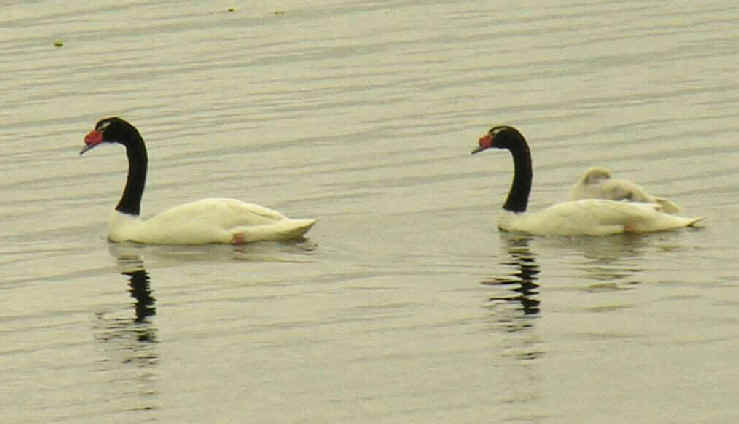 z
z
Black-necked Swans
In another area near
Valdivia, of extensive reedbeds we saw again many birds, including various
ducks, 2 species of ibises, White-tufted
Grebes, Yellow-winged Blackbirds,
Spectacled Tyrants, and the largest Heron
of the Americas, the Cocoi.
But the best was a very small bird in the reeds. The writing
of its name is not different in size than the bird itself, the Many-colored
Rush Tyrant. Its Spanish name is "Siete Colores de la
Laguna", with, let's see, yellow (that's the most obvious),
black, white, blue, red, green, and there must be one more.
The famed Nobel Prize laureate, Pablo Neruda, wrote this poem
about the Many-colored Rush Tyrant (translated here
into English):
In the lagoon the cattail,
the wet reedbed,
some drops alive and aflame:
suddenly a movement,
a minuscule banner,
a scale of the rainbow:
the sun swiftly set it afire.
How were its seven colors combined?
How did it assume all the light?
There it was but was not:
the gust of wind is gone,
perhaps does not exist,
but the cattail is still quivering.
That's how we saw the bird. It was there. Then it wasn't, in the vast
expanse of reeds. But somehow we stopped the vehicle at just the right
place.
As a gift after the tour, I was given a book filled with art
and the poems of Pablo Neruda, relating to many of the
birds that we saw in Chile. Called the "Arte de Pajaros",
or the "Art of Birds", a very nice book, and a
very nice gift indeed.
About to conclude, I must refer to another book that I've had for years,
relating to something else during the tour the must be included in this
narrative: "The Flight of the Condor".
Yes, that's the title of the book and what I must refer to. To
see the Andean Condor fly as did in the High
Andes, during this tour and during all of our Chile tours in the past, is
truly wonderful. Watching the big bird glide against the backdrop of
the mountains is something special.
In those mountains we also saw the Black-chested Buzzard
Eagle fly, and we enjoyed our encounters with the Gray-breasted
Seedsnipes (somewhat like ptarmigans), and the Crag
Chilia (somewhat like the Canyon Wren, but
without its beautiful song).
Those just mentioned were some of the special birds of the tour. Also
worth noting are some of the birds that we saw often that reminded us
of some at home.
The Austral Thrush is similar in its behavior to the American
Robin, in the same Turdus genus.
The Chilean Mockingbird is endemic to Chile. It doesn't
seem to mimic as much as the Northern Mockingbird, but a mockingbird one
knows it is.
The Meadowlark in Chile is with a red, rather than yellow, breast.
And the House Wren sings and sings.
In addition to the birds, some notable among their ancestral relatives, the reptiles,
were seen during the tour. Among them, the Chilean Iguana,
a threatened species smaller than most iguanas and unique in Callopistes
genus, and a truly beautiful lizard, the Lagartija esbelta,
the Thin Tree Lizard. Both are endemic to Chile. About half
of all the reptile species in Chile are endemic to that country.
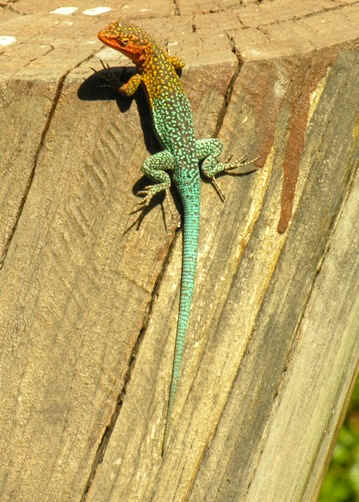
Thin Tree Lizard
Another lizard we came
across in the south was the Southern Grumbler - the only
grumbler during the tour.
Of course! As a good tour it was. And something else, being in Chile in November,
it was spring, with the lengthening days, the singing birds, and the
blooming flowers of so many kinds. November isn't much better
anywhere on Earth.
But having said that, really, a tour in Chile during any month would be
a great time to be there!

Some
Accommodations during the FONT November 2011 Chile Tour

At this
almost-new hostel where we stayed in the Los Rios Region,
we enjoyed a wonderful German dinner.
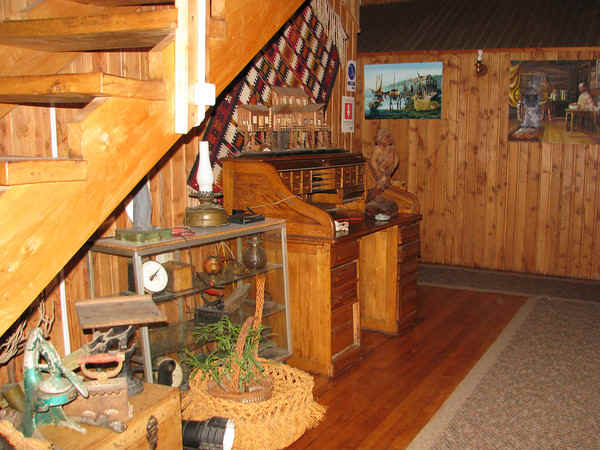
Inside
the hotel where we stayed in Ancud, on Chiloe Island,
there was some character with local art and trinkets.
It was in this hotel that a grouping of local wooden guitars
was on the wall, and in which, one evening,
such a guitar was being played as people sang.
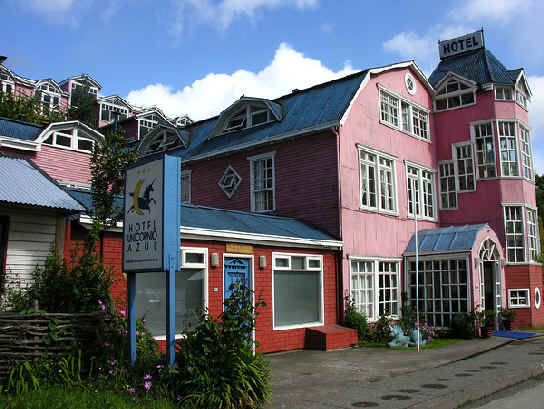
In
this hotel, on Chiloe Island, we had a fine brunch.
It started out as "a coffee", but became a brunch.

Our last
night in Chile was not in the big city of Santiago,
but in a much smaller place, described in even a new guidebook,
as an "easy-going small town, pleasant enough".
It was, for us, very pleasant as our wonderful accommodation,
was a Four Points Sheraton Hotel,
with a casino, that we did not visit,
and an excellent restaurant that we did.
The easy-going, small town is Los Angeles,
"the other Los Angeles" we called it.
To
Top of Page







 z
z
![]()



